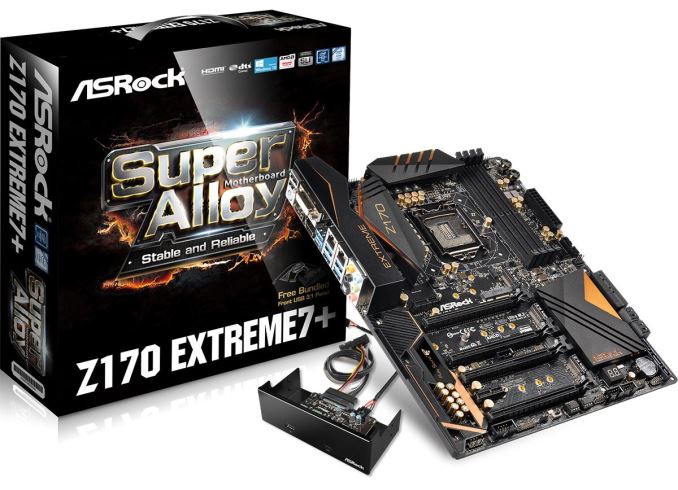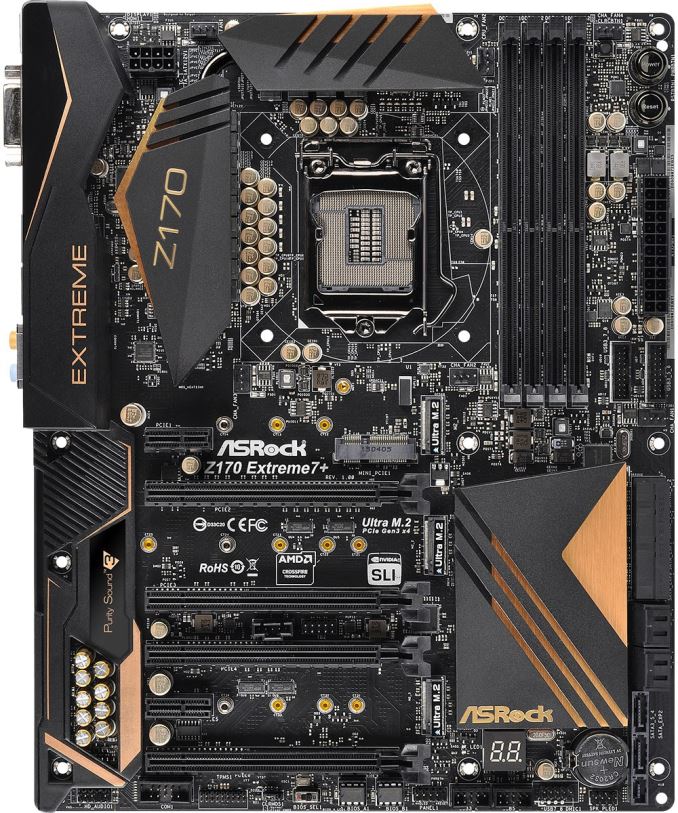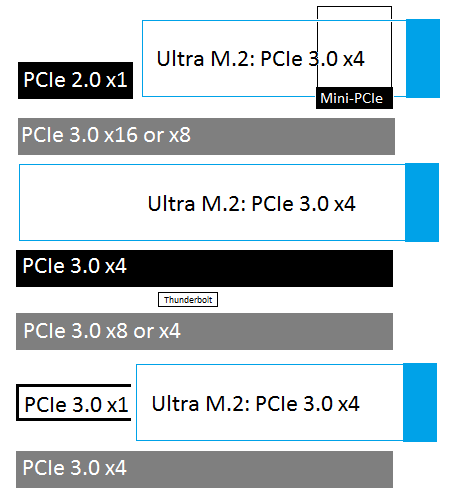The ASRock Z170 Extreme7+ Review: When You Need Triple M.2 x4 in RAID
by Ian Cutress on November 27, 2015 11:59 AM EST- Posted in
- Motherboards
- ASRock
- M.2
- Skylake
- Z170
ASRock Z170 Extreme7+ Conclusion
If you’ve skipped to the conclusion of the review first, answer this question: how important is data access storage to you? Is the main hump moving from a rotating platter drive to a solid state drive, and the rest is just icing on the cake? Or is there a burning need for multiple solid state drives in an array? One of the main selling points of the Z170 Extreme7+ is the ability to have three M.2/U.2 drives based on PCIe and put them into RAID, but how many users are realistically going to set out and buy three SSD 750s or three SM951s/950 Pro M.2 drives either as a JBOD or as a RAID-0? That answer is probably nearer 10 than 10-thousand, but would be a bit excessive to say zero.
ASRock historically does things a little bit differently to other motherboard manufacturers, from using an onboard LSI controller on consumer products to 10 gigabit Ethernet, a mini-ITX high-end desktop platform or using a silicone coating on a motherboard to repel moisture to name a few. In every motherboard manufacturer’s brainstorming room, dozens of ideas are suggested and fall to the floor, either by virtue of impractability, time, or lack of value. It’s that last one which matters the most, because if there is not value to the consumer then there is not much point in pursuing the idea. That what makes ASRock as a company interesting to watch, because their bar for ‘value’ seems to be set differently to everyone else, and this is seen partly in the Z170 Extreme7+.
Very few users will need three PCIe 3.0 x4 based M.2 slots that are RAID capable, but the Z170 chipset was designed to handle that configuration and required someone to actually go and build it. Alongside this, ASRock adds to the two USB 3.1 ports already on board with a USB 3.1 front panel that uses one of those obsolete SATA Express ports (and a USB 2.0 header) to provide a pair of front-facing USB 3.1 ports (A and C), which in itself heralds back 2011 and one of my first AnandTech reviews ever where ASRock bundled a USB 3.0 front panel in a similar fashion.
For features, the dual Intel network ports (I219-V and I211-AT) are joined by a mini-PCIe slot for users to add their own Wi-Fi module, and the onboard audio comes via an enhanced Realtek ALC1150 audio solution. Aside from the two USB 3.1 ports on the rear (A+C), we get four USB 3.0 ports on the rear and two USB 3.0 headers onboard for cases provided by an ASMedia controller. Another ASMedia controller also gives four extra SATA ports, bringing the total to ten which includes space for three SATA Express ports, although there is some switching involved and not all these feature will work at the same time with the M.2 slots also in play.
Benchmark wise, the Extreme7+ does not have MultiCore Turbo by default on the BIOS we tested, but this manifests in a much lower power consumption as a result. POST times for the board are currently the best we have seen on Z170, and the audio solution scores highest in our test so far. The only serious test that had issues was DPC Latency, though I am told that at the time of testing, due to the new platform, BIOSes are still to be optimized. A review is only ever a snapshot in time, meaning that users who purchase this motherboard and care enough about DPC Latency should update the firmware to the latest available when possible.
At $240, it sits above that popular mainstream segment of $140-$200 motherboards that will be the big sellers. The Extreme7+ sits on top of ASRock’s Extreme motherboard product list until an Extreme9/11 comes along, and the benefit of going above the regular extends to multiple Ultra M.2 ports, ten SATA ports, a wealth of USB 3.0 and a bundled USB 3.1 panel. Aside from a regular PC, if you wanted a storage platform with a strong networking base and space for RAID cards, the ASRock Z170 Extreme7+ might just have you covered this side of a high-end desktop arrangement.













63 Comments
View All Comments
phorgan1 - Tuesday, December 22, 2015 - link
And it is 3.93 GB/s for 4 lanes of DMI 3.0nunya112 - Friday, November 27, 2015 - link
no. they will have their own. if there is no video card installed or if they only set the video card to 4Xthat would then dedicate all the lanes
4 will be in the DMI links, then depending if they have video card or not there will be 12 lanes free. meaning it would go full speed at 4X EACH = 12 lanes then the 4 lanes for the video card. or even none if using onboard
phoenix_rizzen - Sunday, November 29, 2015 - link
The video card slots get their lanes direct from the CPU.The M.2 slots get their lanes from the PCH, along with the x1 and x4 slots.
Separate lanes; not shared.
You can run SLI video setup using 16 lanes from the CPU, and still use 12 lanes for M.2.
extide - Monday, November 30, 2015 - link
BUT evilspoons/eddieobscurant are correct. The DMI link is EQUIVALENT to a PCIe 3.0 x4 link. Regardless of the video card setup, the 3 M.2 ports are sharing essentially the B/W of a single PCIe 3.0 x4 link.WITH THAT BEING SAID, this is still my #1 Z170 mobo. The feature combo is PERFECT. DO WANT
phoenix_rizzen - Monday, November 30, 2015 - link
Only if the storage controller is on the CPU, no? The DMI link is between the CPU and the PCH, correct? And the storage controller won't be sending all storage traffic through to the CPU (this isn't IDE), so that shouldn't be a bottleneck.extide - Thursday, December 3, 2015 - link
Where else is the data going to go? I mean if you are copying from one drive to another that are both hanging off the PCH ... I am not sure if it needs to go through the CPU or if it has something like DMA.Ian Cutress - Friday, November 27, 2015 - link
Something seems to have gone awry with our content engine. It should be fixed now.bug77 - Friday, November 27, 2015 - link
One of these babies should be delivered to my door tomorrow. Needless to say, I can't wait.Idrathernotsay - Friday, November 27, 2015 - link
Would it be possible to see a review of one of the lower-end z170 motherboards, even a quick test? I realize that they don't provide much in the way of interesting or remarkable features, but I'd be really interested in seeing what, if anything, you actually lose with a mobo under $100 in performance if you don't care enough about the "crazy" stuff to fork over twice or three times as much cash.Impulses - Friday, November 27, 2015 - link
Didn't they review the ASUS Z170-A? It's a little over your budget but it's one of the better "cover all bases" budget options (2 3.0 headers, Type C in back, M.2, etc). I think when you start going closer to $100 than $150 you do sacrifice a lot more than it's worth, starting with build quality.